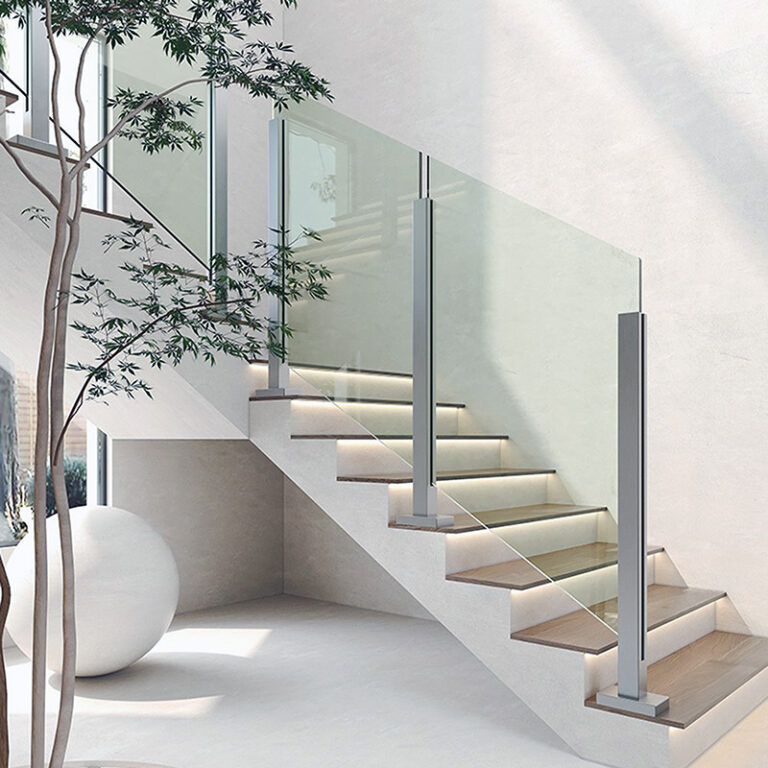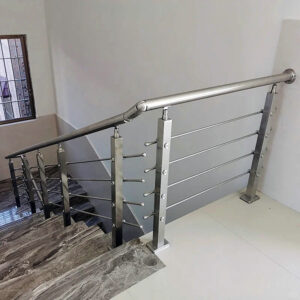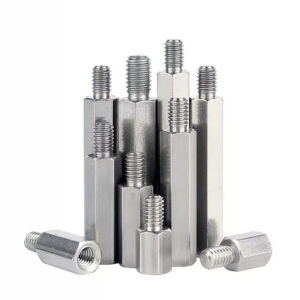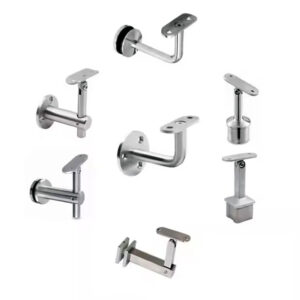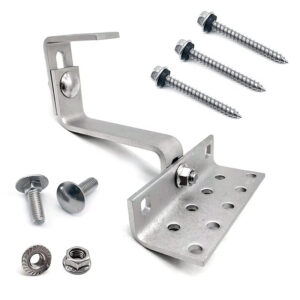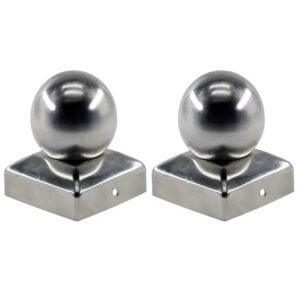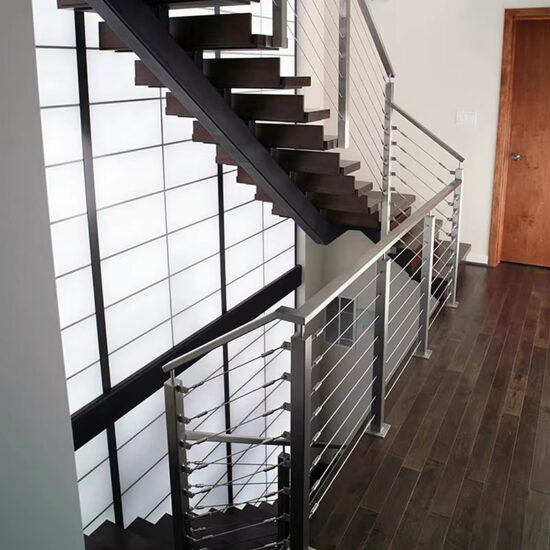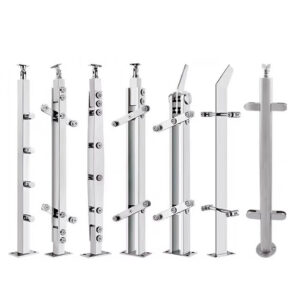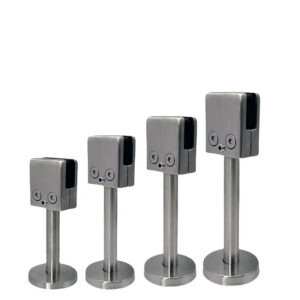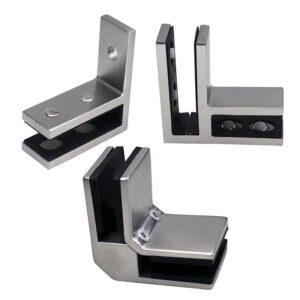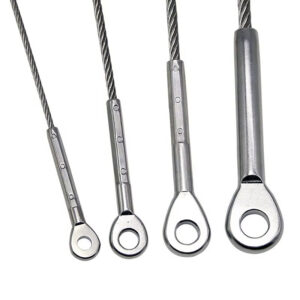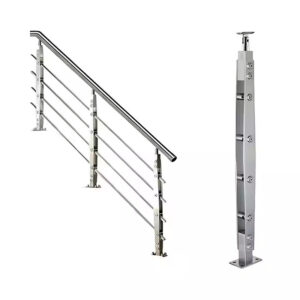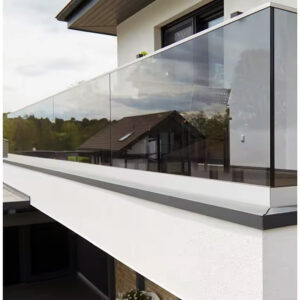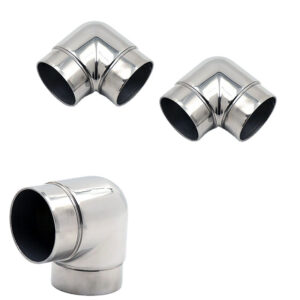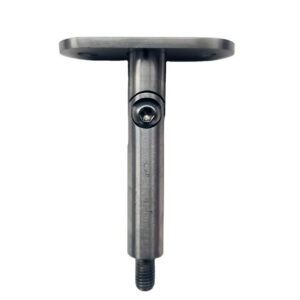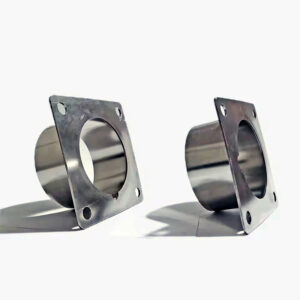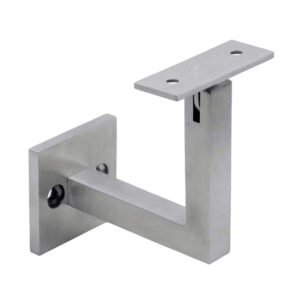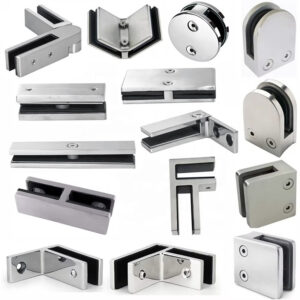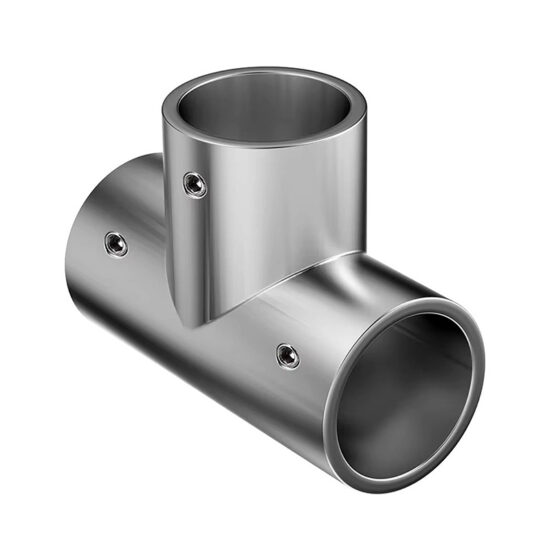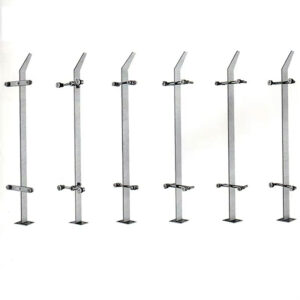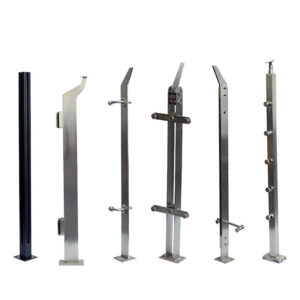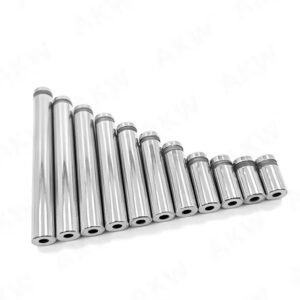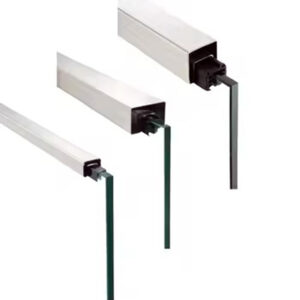Finding interior stair railings that actually deliver on promises—code compliance, straightforward installation, long-term durability—shouldn’t require guesswork. After 23 years manufacturing stainless steel railing systems, we’ve learned what contractors and distributors really need: standardized components that fit properly, specifications that match real-world applications, and supply chain reliability that keeps projects on schedule. Here’s what works in 304 stainless steel interior railing systems and why these solutions solve common installation and maintenance challenges.
Interior Stair Railings 304: System Components That Work Together
Handrail Systems and Mounting Solutions
Interior stair railings 304 systems start with properly engineered handrail components designed for consistent installation. Wall-mounted hanrails use standard 1-1/2″ round or 2″ square profiles with bracket spacing every 4-6 feet per IBC requirements. Surface-mounted systems accommodate varying wall conditions with adjustable brackets that compensate for construction tolerances. Continuous hanrail systems eliminate joints on long runs while maintaining proper support intervals.
Post-mounted configurations integrate with stair structures using welded or mechanical connections. Standard post diameters (2″, 2-1/2″, 3″) match common architectural specifications while providing required structural capacity. Return ends, wall returns, and transition fittings create code-compliant terminations without custom fabrication delays.
Railing Posts and Structural Components
304 stainless steel posts handle interior applications where moderate corrosion resistance meets budget requirements. Wall thickness options (14-gauge, 11-gauge, 10-gauge) correspond to different load requirements and span capabilities. Core-mounted posts work with concrete-filled or structural steel connections, while surface-mounted systems use base plates with adequate anchor patterns.
Intermediate infill systems include glass panel hardware, cable rail components, and traditional picket assemblies. Glass clamps accommodate 3/8″ to 1/2″ tempered panels with EPDM gaskets for consistent grip. Cable systems use 1/8″ or 3/32″ stainless cable with mechanical tensioners and swaged end fittings that maintain proper tension over time.
Material Performance and Grade Selection
304 stainless steel provides adequate corrosion resistance for interior environments while maintaining cost effectiveness compared to 316 grades. Interior applications typically don’t require the enhanced chloride resistance of 316 stainless, making 304 the practical choice for most commercial and residential projects.
Surface finishes affect both appearance and maintenance requirements. #4 brushed finish hides minor scratches and wear patterns better than mirror finishes in high-traffic applications. Mirror polish works well in formal commercial settings where appearance takes priority over maintenance considerations.
| Component Type | 304 Grade Application | Load Capacity | Installation Method |
|---|---|---|---|
| Wall-Mount Handrail | Interior corridors, stairs | 200 lbs concentrated | Bracket spacing 4-6 ft |
| Post-Mount Systems | Open stairs, balconies | 50 lbs/ft distributed | Core or surface mount |
| Glass Panel Hardware | Commercial, residential | Per glazier calculations | Continuous or point-fixed |
| Cable Rail Systems | Modern applications | 40-50 lbs/ft cable load | Through-post or surface |
▶ Get Complete Product Specifications ◀
Technical Specifications for Planning and Installation
Understanding load requirements, material properties, and installation parameters helps avoid common specification problems that delay projects and increase costs.
Load Capacity and Code Compliance
Interior stair railings 304 systems must handle both distributed live loads and concentrated loads per IBC Section 1607.8. Hanrails require 200 pounds concentrated load capacity plus 50 pounds per linear foot distributed load. Guard rails need 200 pounds concentrated at any point plus lateral loads.
Structural calculations vary by span, mounting method, and post spacing. Wall-mounted systems typically handle these loads with standard bracket spacing. Post-mounted systems require proper foundation design and may need core reinforcement for longer spans.
Material Properties and Performance
304 stainless steel contains 18-20% chromium and 8-12% nickel, providing corrosion resistance adequate for interior environments. Yield strength of 30,000 PSI minimum supports structural applications when properly designed. Work hardening during forming increases strength in bent components.
| Property | 304 Stainless Steel | Interior Application Notes |
|---|---|---|
| Corrosion Resistance | Good for indoor use | Adequate for most interior environments |
| Yield Strength | 30,000 PSI minimum | Supports standard guardrail loads |
| Temperature Range | -400°F to 1600°F | No issues in building environments |
| Maintenance | Periodic cleaning | Less frequent than outdoor applications |
| Expected Service Life | 25-30+ years | Interior conditions extend lifespan |
Installation Time and Labor Estimates
Modular railing systems reduce field labor compared to custom fabrication. Standard components with pre-engineered connections typically install 40-50% faster than site-built alternatives. Wall-mounted hanrails average 15-20 linear feet per day for experienced crews. Post-mounted systems vary from 8-12 linear feet per day depending on complexity and site conditions.
Real Applications: What Works in Different Settings
Commercial Interior Projects
Office buildings and retail spaces use interior stair railings 304 for durability and appearance consistency. Multi-story applications benefit from standardized components that maintain uniform appearance throughout the building. Standard profiles and mounting systems simplify specification and reduce coordination issues between trades.
Experience shows that 304 stainless performs well in commercial settings with normal HVAC systems and regular cleaning protocols. Projects typically see 15-20% cost savings compared to 316 stainless without performance compromises in interior environments.
A recent 12-story office building used standardized wall-mounted hanrail systems throughout all stairwells. Standard 1-1/2″ round hanrails with #4 brushed finish provided consistent appearance while bracket standardization reduced installation time by approximately 30% compared to the original custom specification.
Residential and Multi-Unit Housing
Residential interior applications emphasize code compliance and cost control. Standard post spacing and hanrail heights meet residential codes while modular components control costs through standardization. 304 stainless provides adequate durability for residential use patterns.
Multi-unit projects benefit from bulk purchasing and installation standardization. Identical railing configurations across multiple units reduce inventory complexity and speed installation. Standard glass panel systems work well in modern residential applications where open sight lines are desired.
Industrial and Institutional Applications
Manufacturing facilities and institutional buildings require robust systems that handle higher usage levels. 304 stainless works well in clean industrial environments and institutions like schools and hospitals. Heavier wall thickness (11-gauge or 10-gauge) may be specified for high-traffic applications.
“Standardized railing components reduce project time by 25-40% while maintaining consistent quality across multiple building levels.” — Construction Specifications Institute
Industrial applications often require integration with existing structural systems. Modular components adapt to varying conditions while maintaining structural integrity. Custom mounting brackets accommodate unusual structural interfaces without requiring complete system redesign.
▶ Discuss Your Specific Project Requirements ◀
Installation Support and System Integration
Modular Design Benefits
Pre-engineered components eliminate most field fabrication while accommodating normal construction tolerances. Standard connections use common tools and installation techniques. Component compatibility across product lines simplifies inventory and reduces ordering complexity.
Modular systems adapt to varying conditions through adjustable mounting hardware and standard dimensional increments. This flexibility handles normal construction variations without custom modifications that delay installation and increase costs.
Quality Control and Manufacturing Precision
23 years of manufacturing experience has shown that initial component precision prevents installation problems later. CNC machining ensures consistent hole patterns and thread dimensions. TIG welding provides clean joints that polish consistently. Dimensional tolerances match standard construction practices.
Factory quality control includes material certification, dimensional inspection, and finish consistency checks. This front-end control reduces field problems and callbacks that cost time and money on active projects.
Technical Support During Installation
Installation questions arise even with well-planned projects. Technical support includes connection details, load calculations, and troubleshooting assistance. Engineering backup helps resolve unusual conditions or coordination issues with other building systems.
▶ Connect with Technical Support Team ◀
Field support may include installation training for complex systems or review of job-specific conditions that affect standard installation procedures. This support helps maintain project schedules and quality standards.
Frequently Asked Questions
When should I specify 304 vs. 316 stainless steel for interior railings?
304 stainless steel works well for most interior applications where normal HVAC systems control humidity and air quality. 316 grade typically provides unnecessary corrosion resistance at higher cost for interior use. Consider 316 only in special environments like pool areas, commercial kitchens, or chemical processing buildings where enhanced chloride resistance is needed.
What’s the real installation time difference between modular and custom systems?
Experience shows modular systems install 30-40% faster than field-fabricated alternatives. Standard connections use common tools and techniques while pre-engineered components eliminate field measuring and cutting. A typical floor of office hanrails might install in 1-2 days with modular systems versus 2-3 days for custom work.
How do I handle non-standard dimensions and site conditions?
Modular systems accommodate most variations through adjustable mounting hardware and standard increment sizing. Unusual conditions may require custom brackets or transition pieces, but the basic system remains standard. This hybrid approach balances flexibility with cost control.
What maintenance should I expect with 304 stainless interior railings?
Interior applications typically require only periodic cleaning with mild soap and water. Avoid chloride-containing cleaners that can cause surface staining. #4 brushed finishes hide minor scratches and wear better than mirror finishes in high-traffic areas. Annual inspection and cleaning maintains appearance and performance.
How do I coordinate railing systems with glass, cable, or other infill requirements?
Standard post and hanrail systems accommodate different infill options through compatible hardware designs. Glass clamps, cable fittings, and picket connections use standard mounting patterns. This compatibility allows infill changes during design development without affecting the basic structure.
What’s included with technical support and engineering backup?
Technical support includes installation guidance, connection details, and load calculation verification. Engineering backup helps with unusual conditions or integration challenges. Esang Metal provides this support based on 23 years of manufacturing and application experience across thousands of projects.
Making the Right Choice for Your Project
Selecting interior stair railings 304 systems requires balancing performance requirements, installation constraints, and budget considerations. Standard systems provide cost control and schedule predictability while maintaining code compliance and durability expectations.
| Consideration | Standard Systems | Custom Solutions |
|---|---|---|
| Initial Cost | Lower material and fab costs | Higher engineering and fabrication |
| Installation Time | 30-40% faster typically | Longer field work required |
| Quality Control | Factory precision and testing | Field fabrication variability |
| Technical Support | Proven installation procedures | Project-specific problem solving |
| Schedule Risk | Lower due to standardization | Higher due to custom elements |
“Modular railing systems consistently deliver better schedule performance while maintaining quality standards across diverse project types.” — National Association of Construction Contractors
▶ Get Project-Specific Recommendations ◀
The key is matching system capabilities to actual project requirements without over-specifying performance that won’t be used or under-specifying durability that affects long-term costs. 23 years of experience shows that most interior applications are well-served by standardized 304 stainless systems with selective customization only where truly needed.
